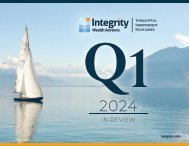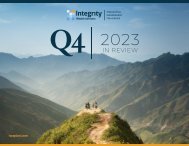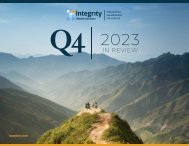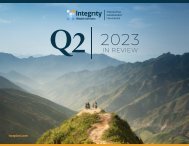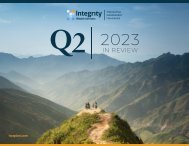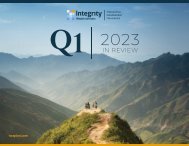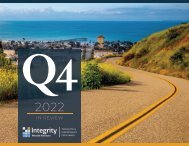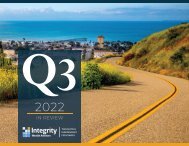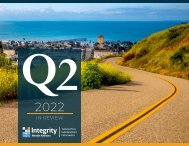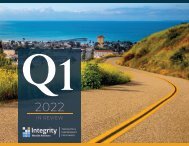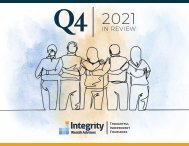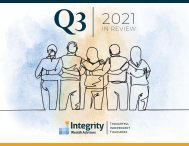You also want an ePaper? Increase the reach of your titles
YUMPU automatically turns print PDFs into web optimized ePapers that Google loves.
iwaplan.com<br />
<strong>Q3</strong> <strong>2023</strong><br />
IN REVIEW
TOTAL RETURN <strong>2023</strong> <strong>Q3</strong> + NEWSWORTHY EVENTS<br />
July 5 – The Fed’s<br />
June meeting minutes<br />
indicate more rate hikes<br />
are likely on the way<br />
July 26 – The Federal Reserve<br />
raised the federal funds rate to<br />
5.50%, the highest level in 22 years<br />
August 8 – On Maui, a series of<br />
wildfires burned 17,000 acres of<br />
land, leaving at least 98 people<br />
dead and 31 others missing<br />
September 9 – a 6.9 magnitude<br />
earthquake strikes Marrakesh,<br />
killing at least 2,960 people<br />
July 12 – The Consumer<br />
Price <strong>In</strong>dex (CPI) report<br />
showed that headline<br />
inflation was up 3.1% for<br />
the last year, the lowest<br />
reading since August 2021<br />
August 1 – U.S. Treasury<br />
Bonds were downgraded<br />
from AAA to AA+ by<br />
ratings agency Fitch<br />
August 15 – The stock market<br />
fell following better than<br />
expected economic reports<br />
on consumer spending,<br />
suggesting sticker inflation<br />
and a more aggressive Fed<br />
September 15 – The<br />
United Auto Workers<br />
begin a strike against<br />
the three largest<br />
American automakers<br />
September 20 – The<br />
Federal Reserve<br />
decided to hold interest<br />
rates at 5.50% but<br />
notes than another 25<br />
basis point raise was<br />
not off the table for the<br />
remainder of <strong>2023</strong><br />
4%<br />
S&P 500 TOTAL RETURN<br />
MSCI ACWI EX USA TOTAL RETURN<br />
BARCLAYS US AGGREGATE TOTAL RETURN<br />
3%<br />
2%<br />
1%<br />
0%<br />
-1%<br />
-2%<br />
-3.27%<br />
-3%<br />
-3.23%<br />
-4%<br />
-3.68%<br />
July<br />
August<br />
September<br />
As of close 9/29/<strong>2023</strong><br />
12%<br />
S&P 500 TOTAL RETURN<br />
MSCI ACWI EX USA TOTAL RETURN<br />
BARCLAYS US AGGREGATE TOTAL RETURN<br />
Source: https://en.wikipedia.org/wiki/<strong>2023</strong><br />
11%<br />
10.42%
A SURPRISINGLY RESILIENT ECONOMY DESPITE<br />
A HAWKISH FED<br />
<strong>2023</strong><br />
<strong>Q3</strong><br />
IN REVIEW<br />
The financial markets faced significant challenges in the third quarter.<br />
Equities struggled as a bearish sentiment took hold in recent months. The<br />
initial momentum, driven by a disinflation narrative from October 2022 to July<br />
<strong>2023</strong>, was overshadowed by less supportive storylines, leaving equities in a<br />
precarious position amidst the resilient economy.<br />
Despite efforts, inflation improvement remains elusive due to persistent wage<br />
stagnation. While U.S. consumers didn't cause the pandemic-related price<br />
surge, they are now demanding higher wages. This robust labor force is a<br />
reason why the Federal Reserve is cautious in easing its policies, hinting at<br />
a prolonged period of restrictive measures, which is impacting both equities<br />
and bonds.<br />
This tightening of financial conditions is happening in an economy that,<br />
at the moment, seems capable of absorbing it. Consumers are financially<br />
stable, employment markets are robust, corporate profits are rising, and fiscal<br />
policies are surprisingly pro-cyclical for this stage of expansion. Consequently,<br />
the rise in yields seems justified given the resilient economy and the hawkish<br />
stance of the Fed. While the threat of a recession looms in 2024, for now, the<br />
market's fate hangs on oil prices and the U.S. 10-year Treasury yield.<br />
Traditionally, interest rates would be at new lows during this expansion<br />
phase, stimulating the economy through refinancing and increased housing<br />
demand. However, investors are now grappling with a gradual reduction in<br />
liquidity, reflected in the narrowing gains across financial assets. Despite<br />
healthy nominal economic growth, the ongoing contraction of money and<br />
credit implies a limited shelf life for this prosperity. <strong>In</strong>vestors remain skeptical<br />
about the soft-landing theory unless there's a significant change in the current<br />
scenario. The longer the economy stays resilient, the higher the chances of a<br />
harsher economic downturn.<br />
Real interest rates are higher, emphasizing the time value of money and<br />
marking a departure from the post-2008 era of easy money. Consequently,<br />
considering valuations is crucial in investment decisions. The era of pursuing<br />
growth at any cost is becoming increasingly difficult to justify.<br />
ECONOMIC CHARTS & NOTES<br />
CONSUMER SENTIMENT Consumer sentiment improved in <strong>Q3</strong>, reaching its<br />
highest level in nearly two years, although autoworker strikes and the government<br />
shutdown added uncertainty. Retail sales picked up as American shoppers stayed<br />
resilient.<br />
US Retail Sales<br />
Consumer Sentiment<br />
EMPLOYMENT The U.S. unemployment rate rose to 3.8% (its highest level since<br />
February 2022), a sign that the jobs market may be cooling. Job gains were better<br />
than expected in August, led by healthcare, but June/July figures were revised lower.<br />
Unemployment Rate<br />
NonFarm Payroll<br />
34%<br />
100<br />
16%<br />
2200<br />
US Retail Sales % Chg<br />
28%<br />
22%<br />
16%<br />
10%<br />
4%<br />
-2%<br />
-8%<br />
90<br />
80<br />
70<br />
60<br />
Consumer Sentiment<br />
Unemployment Rate %<br />
14%<br />
12%<br />
10%<br />
8%<br />
6%<br />
4%<br />
-825<br />
-3850<br />
-6875<br />
-9900<br />
-12925<br />
-15950<br />
-18975<br />
NonFarm Payroll<br />
-14%<br />
Jan '19<br />
Jul '19<br />
Jan '20<br />
Jul '20<br />
Jan '21<br />
Jul '21<br />
Jan '22<br />
Jul '22<br />
Jan '23<br />
50<br />
Jul '23<br />
2%<br />
Jan ' 19<br />
Jul '19<br />
Jan '20<br />
Jul '20<br />
Jan '21<br />
Jul '21<br />
Jan '22<br />
Jul '22<br />
Jan '23<br />
Jul ' 23<br />
-22000<br />
Source: University of Michigan Consumer Sentiment. Retail Sales - U.S. Census Bureau.<br />
Source: U.S. Bureau of Labor Statistics
ECONOMIC CHARTS & NOTES<br />
CONSUMER PRICE INDEX The overall CPI had it biggest monthly gain<br />
of <strong>2023</strong> due to a surge in gasoline prices. Core inflation, excluding food and<br />
energy, was hotter than expected in August.<br />
CONSUMER SPENDING Consumer purchasing power slipped in <strong>Q3</strong> as wage<br />
growth failed to keep up with inflation. Household spending cooled in August but<br />
remains above 2022 levels.<br />
Y/Y % Chg<br />
8%<br />
7%<br />
6%<br />
5%<br />
4%<br />
3%<br />
2%<br />
1%<br />
0%<br />
CPI Less Food<br />
2018 2019 2020 2021<br />
CPI All<br />
2022 <strong>2023</strong><br />
% Chg Year-over-year<br />
35<br />
30<br />
25<br />
20<br />
15<br />
10<br />
5<br />
0<br />
-5<br />
-10<br />
-15<br />
-20<br />
-25<br />
Jan '19<br />
Jul '19<br />
Consumption<br />
Jan '20 Jul ' 20 Jan '21<br />
Jul '21<br />
Jan '22<br />
Disposable <strong>In</strong>come<br />
Jul '22 Jan '23 Jul '23<br />
Source: U.S. Bureau of Labor Statistics<br />
Source: U.S. Bureau of Economic Analysis<br />
JOB OPENINGS & HIRES Retail hires and job openings were relatively flat<br />
for the period. Some retailers, like Amazon, are ramping holiday season hiring,<br />
while Target and others are being more cautious.<br />
GDP The Fed's GDPNow model estimates the economy grew 4.9% in the third<br />
quarter, amid resilient consumer spending and healthy net export activity.<br />
Retail Openings<br />
Retail Hires<br />
GDP<br />
Amount in Thousands<br />
1500<br />
1200<br />
900<br />
600<br />
300<br />
0<br />
Jan '18<br />
Jul '18<br />
Jan '19<br />
Jul '19<br />
Jan '20<br />
Jul '20<br />
Jan '21<br />
Jul '21<br />
Jan '22<br />
Jul '22<br />
Jan '23<br />
Jul '23<br />
% Growth<br />
35%<br />
30%<br />
25%<br />
20%<br />
15%<br />
10%<br />
5%<br />
0%<br />
-5%<br />
-10%<br />
-15%<br />
-20%<br />
-25%<br />
-30%<br />
Q1 Q2 <strong>Q3</strong> Q4 Q1 Q2 <strong>Q3</strong> Q4 Q1 Q2 <strong>Q3</strong> Q4 Q1 Q2 <strong>Q3</strong> Q1 Q4 Q2 <strong>Q3</strong> Q4 Q1 Q2<br />
2018<br />
2019 2020 2021 2022 <strong>2023</strong><br />
Source: U.S. Bureau of Labor Statistics<br />
Source: U.S. Bureau of Economic Analysis
U.S. ECONOMY HIT BY ROLLING RECESSION<br />
<strong>2023</strong><br />
<strong>Q3</strong><br />
IN REVIEW<br />
What happened to the widely predicted recession that was supposed to wreak havoc on the U.S. economy this year? It happened. Just not all at once.<br />
Different sectors of the economy have experienced downturns at different times. Thanks to this rare case of a “rolling” recession, the U.S. may not experience a<br />
traditional recession at all this year, or next, even with the dual pressures of elevated inflation and high interest rates.<br />
“Mini” recessions have rolled across different industries and sectors<br />
Travel<br />
Travelers through TSA checkpoints (millions)<br />
Oil<br />
WTI crude oil spot price (USD per barrel)<br />
3<br />
2<br />
1<br />
0<br />
2019 2020 2021 2022 <strong>2023</strong><br />
Housing<br />
S&P CoreLogic Case-Shiller 20-City Composite Home Price <strong>In</strong>dex<br />
(month-over-month % change)<br />
3<br />
2<br />
1<br />
0<br />
–1<br />
–2<br />
2019 2020 2021 2022 <strong>2023</strong><br />
120<br />
80<br />
40<br />
0<br />
2019 2020 2021 2022 <strong>2023</strong><br />
Semiconductors<br />
Philadelphia Stock Exchange Semiconductor <strong>In</strong>dex cumulative return (%)<br />
250<br />
200<br />
150<br />
100<br />
50<br />
0<br />
2019 2020 2021 2022 <strong>2023</strong><br />
Sources: Travel: Transportation Security Agency (TSA), U.S. Department of Homeland Security. Data is a 30-day moving average. As of August 31, <strong>2023</strong>. Oil: Refinitiv Datastream. As of August 31, <strong>2023</strong>. Housing: Refinitiv Datastream,<br />
Standard & Poor’s. Latest available monthly data is June <strong>2023</strong>, as of September 5, <strong>2023</strong>. Semiconductors: Philadelphia Stock Exchange, Refinitiv Datastream. As of August 31, <strong>2023</strong>. Data represents cumulative price return since January 1,<br />
2019. Past results are not predictive of results in future periods.<br />
Sources: © <strong>2023</strong> Capital Travel: Group. Transportation All rights reserved. Security Agency (TSA), U.S. Department of Homeland Security. Data is a 30-day moving average. As of August 31, <strong>2023</strong>. Oil: Refinitiv Datastream. As of August 31, <strong>2023</strong>. Housing:<br />
Refinitiv Datastream, Standard & Poor’s. Latest available monthly data is June <strong>2023</strong>, as of September 5, <strong>2023</strong>. Semiconductors: Philadelphia Stock Exchange, Refinitiv Datastream. As of August 31, <strong>2023</strong>. Data<br />
represents cumulative price return since January 1, 2019. Past results are not predictive of results in future periods.<br />
6
AS RATE HIKES NEAR END, HISTORIC INVESTOR<br />
OPPORTUNITY MAY BEGIN<br />
To say this has been an interesting year in financial markets is an<br />
understatement. Equities have been stronger than most expected, and the<br />
10-year U.S. Treasury yield is up 71 basis points as of September 30. So where<br />
are we now as we head into the homestretch of <strong>2023</strong>? We believe we’re on the<br />
cusp of a major transition, one where long-term investors can find attractive<br />
income opportunities as central banks pivot from restrictive monetary policy<br />
to something that looks much more benign.<br />
Last year was shocking to many in the investment community; it marked the<br />
first time in at least 45 years that both stocks and bonds posted negative<br />
returns in a calendar year. Battling high inflation, the Federal Reserve raised<br />
interest rates aggressively. Those hikes hurt absolute results across the<br />
board. The usual role of high-quality bonds to provide diversification from<br />
stock market volatility — something investors rely on — broke down.<br />
Turbulent markets in 2022, plus the prospect of relatively high yields in money<br />
markets, led investors to flock to cash-like alternatives. Money market funds<br />
were at an all-time high of $5.6 trillion as of September 6, according to the<br />
<strong>In</strong>vestment Company <strong>In</strong>stitute. Cash investments still look compelling to<br />
many investors today, but the Fed appears to be nearing a turning point.<br />
History teaches us that this may be an opportune time to shift back to stocks<br />
and bonds.<br />
Sources: Capital Group, Bloomberg <strong>In</strong>dex Services Ltd., Standard & Poor's. Each dot represents an annual stock and bond market return from 1977 through 2022. Stock returns represented by the S&P 500 <strong>In</strong>dex. Bond<br />
returns represented by the Bloomberg U.S. Aggregate <strong>In</strong>dex. Past results are not predictive of results in future periods.
UNDERSTANDING THE RISE IN BOND YIELDS<br />
<strong>2023</strong><br />
<strong>Q3</strong><br />
IN REVIEW<br />
The incredible resilience of the U.S. economy,<br />
highlighted by September’s payroll numbers, has<br />
caused government bond yields to rise sharply.<br />
Steepening of the yield curve creates a compelling<br />
opportunity for investors in money markets to<br />
consider adding longer-duration assets, in our<br />
view. Starting yields are high relative to history<br />
and to other asset classes on a risk-adjusted<br />
basis. This can create a “yield cushion” amid a still<br />
highly uncertain outlook. <strong>In</strong> addition, bonds have<br />
the potential to earn capital gains and diversify<br />
portfolios. <strong>In</strong>deed, investors can now seek to<br />
construct resilient portfolios, pursuing robust yields<br />
and predictable flows, with a moderate amount of<br />
risk.<br />
The spike in rates is also working to tighten<br />
financial conditions by making new debt much more<br />
expensive. This should eventually raise the cost<br />
of existing debt as fixed terms run out on loans to<br />
businesses and households. Higher yields have<br />
already contributed to stagnating flows of new<br />
loans this year. We believe this may eventually slow<br />
economic activity and moderate inflation enough for<br />
central banks to ease.<br />
Paradoxically, yields have jumped despite developed<br />
market central banks having neared the end of their<br />
respective hiking cycles, and as headline inflation<br />
rates have moderated meaningfully. This has raised<br />
questions about the underlying drivers of the recent<br />
market repricing.<br />
Consider that U.S. Treasury yields have risen and<br />
the yield curve has steepened with real rates –<br />
indicated by yields on Treasury <strong>In</strong>flation-Protected<br />
Securities (TIPS) – leading nominal bond yields<br />
higher. By contrast, the spread between real and<br />
nominal rates, or the breakeven inflation spread,<br />
hasn’t changed much at all. This suggests that<br />
investors aren’t worried about inflation risks, but are<br />
nevertheless demanding a higher real term premium<br />
to hold longer-maturity government bonds.<br />
Why would investors all of a sudden demand more<br />
real term premium? At the heart of it, we think<br />
it relates to a combination of factors that have<br />
recently shifted private investors’ outlook about<br />
future government bond supply. Expectations of<br />
greater supply have meant a higher yield required by<br />
the marginal investor. These factors include:<br />
1. More resilient economies and lower recession<br />
risks. This suggests that central banks can<br />
continue for longer to reduce their holdings<br />
of government bonds. The process, known<br />
as quantitative tightening or “QT,” tends to<br />
boost the supply of bonds in the market and<br />
tighten financial conditions. Earlier in the year,<br />
the U.S. regional banking crisis led to a steep<br />
drop in policy rate expectations and lower<br />
term premiums embedded in longer-dated<br />
bonds. Markets were pricing in the prospect<br />
of recession and policy easing, including a<br />
cessation of QT.<br />
2. Resilience in developed economies outside<br />
the U.S. Importantly, this has reignited enough<br />
inflationary pressures in Japan for its central<br />
bank to ease away from its yield curve control<br />
policy. Over the past decade, the Bank of Japan<br />
(BOJ) has been an important source of demand<br />
for Japanese Government Bonds (JGBs). This<br />
crowded out Japanese domestic investors from<br />
their local bond markets, increasing demand<br />
for global bonds. Now that the BOJ is easing<br />
away from these policies, there should be more<br />
JGBs for the private sector to buy to finance<br />
Japanese government deficits – thus reducing<br />
demand for Treasuries.<br />
3. The outlook for the U.S. deficit has also been<br />
ratcheted up. <strong>In</strong> particular, there have been<br />
growing concerns over the future cost of<br />
government tax credits and subsidies related<br />
to green energy investments. <strong>In</strong> May, the<br />
Congressional Budget Office (CBO) revised<br />
higher its 10-year outlook for costs stemming<br />
from last year’s <strong>In</strong>flation Reduction Act – the<br />
largest-ever investment into addressing climate<br />
change. Private forecasters have asserted that<br />
because these new government incentives<br />
are uncapped, even the CBO’s latest estimates<br />
may be grossly underappreciating longer-term<br />
costs. That could require increased issuance of<br />
Treasuries.<br />
These factors have raised fresh questions<br />
about U.S. debt sustainability. Government debt<br />
loads have gotten more expensive to service<br />
as interest costs rise amid moderating nominal<br />
growth. Concerns about debt-sustainability were<br />
exacerbated by Fitch’s downgrade of the U.S.’s<br />
sovereign credit rating to AA+ from AAA in August.<br />
However, the spread between Italian government<br />
bonds and matched-maturity German bonds has<br />
also widened in Europe as investors grapple with<br />
debt-sustainability questions there.<br />
INVESTMENT IMPLICATIONS<br />
The normalization in the shape of the yield curve<br />
and repricing of real yields reflects investors’<br />
demand for higher yields in the face of greater<br />
supply. However, what’s good for investors is<br />
not necessarily sustainable for the economy<br />
over the medium term. Higher rates have further<br />
tightened financial conditions, which should weigh<br />
on investment, real GDP growth, and eventually<br />
inflation. <strong>In</strong> other words, higher yields that tighten<br />
financial conditions are just what the economy<br />
needs for yields to decline.<br />
Thus, high starting yields plus the potential for<br />
capital appreciation and portfolio diversification<br />
can create attractive opportunities in fixed income<br />
markets, in our view. <strong>In</strong>deed, investors can seek to<br />
construct resilient portfolios, with robust yields and<br />
predictable flows, with a moderate amount of risk.<br />
SOURCE: Pimco
INVESTMENT<br />
MANAGEMENT<br />
PHILOSOPHY<br />
The complex, ever-changing investment world of today<br />
requires an investment process that is overseen by a team<br />
of experienced investment professionals. Global capital<br />
markets present investors with a host of challenges due to<br />
the combination of an overwhelming amount of information<br />
to analyze and the endless supply of conflicting opinions and<br />
narratives surrounding financial markets. The time and expertise<br />
required to perform in-depth investment research and to make<br />
timely and informed portfolio management decisions requires<br />
both a clear investment process and an experienced investment<br />
team to implement the process.<br />
An old adage states that there is accomplishment through<br />
many advisors. We agree and embrace a variety of investment<br />
perspectives through our investment committee. Our investment<br />
philosophy is well grounded in global macro-economic analysis.<br />
<strong>In</strong>vestment ideas are carefully vetted through a process which<br />
incorporates the diverse range of investment backgrounds<br />
within our firm. This process of multifaceted analysis ensures<br />
that only the strongest investment ideas survive. We are<br />
committed to striking the right balance between risk and<br />
return through managing global, multi-asset class investment<br />
portfolios.<br />
INDEPENDENCE &<br />
CLIENT FOCUS<br />
DIVERSIFICATION<br />
TOP-DOWN, THEMATIC<br />
APPROACH<br />
PERFORMANCE WITH<br />
LIQUIDITY<br />
VARIED INVESTMENT<br />
PERSPECTIVES<br />
OPTIMIZATION OF<br />
EXPENSES AND TAXES<br />
THE INVESTMENT PROCESS<br />
ASSESSMENT OF GLOBAL<br />
ECONOMIC & INVESTMENT<br />
ENVIRONMENT<br />
ASSESS & ANALYZE<br />
THEMES<br />
RESEARCH INVESTMENT<br />
VEHICLES TO FIND<br />
EFFECTIVE IMPLEMENTATION<br />
IDENTIFY<br />
OPPORTUNITIES<br />
STRATEGIC ASSET<br />
ALLOCATION -<br />
Geographies, Sectors,<br />
Capitalizations<br />
INVESTMENT SELECTION -<br />
Open/Closed End Funds, ETFs, Stocks & Bonds
INVESTMENT COMMITTEE<br />
<strong>2023</strong><br />
<strong>Q3</strong><br />
IN REVIEW<br />
The <strong>In</strong>vestment Committee meets formally each quarter,<br />
and more frequently if market conditions warrant, to discuss<br />
the state of the global economy and capital markets and<br />
to assess the current asset allocation and positioning of<br />
our portfolios. There’s an art to striking the right balance<br />
between risk and return; pursuing that symmetry is the core<br />
of our investment philosophy. We are fiduciaries and have<br />
our interests aligned with our advisory clients, as we invest<br />
alongside them. Contact us at investmentcommittee@<br />
iwaplan.com with any questions or concerns.<br />
STEPHEN WAGNER<br />
CEO, <strong>In</strong>vestment Advisor,<br />
CFP ® , CPFA<br />
MARTHA LAFF<br />
<strong>In</strong>vestment Advisor,<br />
ChFC ® , CLU ® , CRPC ®<br />
CHRISTOPHER WAGNER<br />
<strong>In</strong>vestment Advisor &<br />
Financial Planner, CPFA<br />
MARGARET MARAPAO<br />
<strong>In</strong>vestment Advisor &<br />
Financial Planner, CFP ®<br />
LAINE MILLER<br />
<strong>In</strong>vestment Advisor &<br />
Financial Planner, CFP ®<br />
JOE BARONI<br />
<strong>In</strong>vestment Advisor &<br />
Financial Planner, CFP ®<br />
BOB CHEATHAM<br />
Financial Planner,<br />
CRPS®, MA<br />
DOUG ECKER<br />
<strong>In</strong>vestment Advisor &<br />
Financial Planner, CRPS®<br />
ANDREW MURTHA<br />
Financial Analyst,<br />
MBA<br />
* Financial services experience. <strong>In</strong>vestment Advisory Services are offered through investment advisor representatives of <strong>In</strong>tegrity <strong>Wealth</strong> <strong>Advisors</strong>, a Federally Registered <strong>In</strong>vestment Advisor.<br />
Bob Cheatham, Doug Ecker, Laine Miller, Joe Baroni and Christopher Wagner are solely investment advisor representatives of <strong>In</strong>tegrity <strong>Wealth</strong> <strong>Advisors</strong>. LLC. and not affiliated with LPL Financial.<br />
THOUGHTFUL<br />
INDEPENDENT<br />
FIDUCIARIES<br />
<strong>In</strong>tegrity <strong>Wealth</strong> <strong>Advisors</strong> has<br />
been committed to helping<br />
individuals, families, and<br />
businesses grow, preserve, and<br />
distribute wealth since 1979<br />
VENTURA<br />
196 S Fir St, Ste 140<br />
<strong>Ventura</strong>, CA 93001<br />
(805) 339-0760<br />
ventura@iwaplan.com<br />
OJAI<br />
205 S Signal St,<br />
<strong>Ojai</strong>, CA 93023<br />
(805) 646-3729<br />
ojai@iwaplan.com
THE IMPACT OF<br />
SOUND FINANCIAL<br />
PLANNING<br />
PAY OFF STUDENT LOANS OR SAVE<br />
FOR RETIREMENT?<br />
Recent Vanguard research 1 shows that an experienced<br />
wealth management team not only adds peace of mind,<br />
but also may add about 3 percentage points of value in<br />
net portfolio returns over time. What does this mean? Your<br />
team has the ability and the time to evaluate your portfolio<br />
investments, meet with you to discuss objectives, and<br />
help get you through tough markets. All of these factored<br />
together potentially add value to your net returns (returns<br />
after taxes and fees) over time. But the most interesting part<br />
of this research is that it shows that financial planning and<br />
financial coaching contributed to the greater majority of the<br />
added net 3% in net portfolio returns.<br />
It’s important to realize how valuable making sound financial<br />
planning decisions is and that value is added by your<br />
financial planning team. As investors, our emotions can be<br />
our worst enemy, especially when the markets are volatile,<br />
and guidance from a “behavioral coach” can save us from<br />
panic-selling and abandoning long-term financial plans.<br />
Numerous studies demonstrate that advisors can have a<br />
huge impact on investor finances, but it’s hard to say if these<br />
findings have been recognized and understood by everyday<br />
investors.<br />
DREAM.<br />
PLAN.<br />
ENJOY.<br />
After a three-year pause during the<br />
pandemic, student loan payments are back.<br />
This also marks the return of a perennial<br />
question for recent (and, in this case,<br />
not-so-recent) grads: Should I pay down<br />
my student loans before I start saving for<br />
retirement?<br />
It can be tempting to postpone saving for<br />
things like an emergency fund or goals<br />
like retirement, especially if you're young<br />
and aren't making a lot of money. However,<br />
thanks to the power of compounding,<br />
setting aside even small amounts<br />
when you’re young could help you build<br />
significant savings by the time you're<br />
retired.<br />
It's not impossible to tackle student debt<br />
while also saving for retirement. Consider<br />
prioritizing these steps:<br />
1. Make the minimum loan payments<br />
The cardinal rule for paying off student debt<br />
is: Don't miss payments. Make at least the<br />
minimum payment on every loan and ensure<br />
the amount fits your monthly budget. As<br />
you repay your loan, you're establishing<br />
credit history, and your student loan interest<br />
payments may be tax-deductible if your<br />
adjusted gross income is less than $85,000<br />
($175,000 for joint returns). So, there's an<br />
upside to starting payments and making<br />
them on time.<br />
2. Maximize 401(k) contributions to at least<br />
get the match<br />
Your next priority is to consider your<br />
qualified workplace retirement plan. You'll<br />
want to contribute as much as you can<br />
afford to your 401(k)—or 403(b) if you<br />
work for a nonprofit or 457(b) if you're<br />
a government employee—up to your<br />
employer's match. Not contributing enough<br />
to receive the match (often 5% or 6%)<br />
is turning down what's effectively "free<br />
money."<br />
3. Pay off high-interest-rate debt<br />
Debt with a high interest rate, such as that<br />
held on a credit card, can quickly pile up—<br />
especially if you carry over your balance<br />
from month to month. Start by cutting back<br />
your credit card use and put extra money<br />
toward your balance. With less debt, you'll<br />
be able to save more for retirement and<br />
other financial goals.<br />
4. Build an emergency fund<br />
Life happens, and you should plan for<br />
the unexpected. Otherwise, you might<br />
find yourself relying on your credit card<br />
or retirement savings during a financial<br />
setback. Keep the money in a high-interest<br />
savings or money market account where it<br />
can grow and where you can easily access<br />
it should you need to make a withdrawal.<br />
5. Put additional funds to work<br />
When you're fortunate enough to have<br />
leftover funds, use them wisely. After you've<br />
paid your debts—and yourself—consider<br />
investing the rest in the market. While<br />
investing involves risks and you could lose<br />
money in the market, you may also gain<br />
more from investment returns over the long<br />
run.<br />
The bottom line<br />
Juggling student debt can be tricky but<br />
investing in your future is worth it. College<br />
graduates can successfully manage loan<br />
repayment while saving for retirement. You<br />
don't have to choose one over the other, let<br />
us help you navigate these decisions.
HEALTH CARE COSTS IN RETIREMENT – ARE YOU PREPARED?<br />
Even if you've been saving diligently, health care costs can throw a wrench in<br />
your retirement plans. A report from the Employee Benefit Research <strong>In</strong>stitute<br />
estimates a 65-year-old couple could need as much as $383,000 in savings<br />
to have a 90% chance of covering their health care expenses—including<br />
premiums, deductibles, prescriptions, and out-of-pocket costs—in retirement.<br />
Here are four strategies to consider before you reach retirement age.<br />
1. MAKE THE MOST OF AN HSA<br />
If you're enrolled in a high-deductible health care plan (HDHP) that offers a<br />
health savings account (HSA), consider using it to sock away extra money<br />
for future medical needs. You can make tax-deductible contributions of up<br />
to $3,850 for individual coverage and $7,750 for a family in <strong>2023</strong>—plus an<br />
additional $1,000 for those ages 55 and older.<br />
Your earnings grow tax-free, and withdrawals of contributions and earnings are<br />
tax- and penalty-free when used for qualified health care expenses, including<br />
Medicare and long-term care (LTC) insurance premiums. And once you reach<br />
age 65, withdrawals from an HSA can be used for any purpose without penalty,<br />
although ordinary income taxes will apply to funds used for nonmedical<br />
expenses.<br />
2. ENROLL IN MEDICARE AT THE RIGHT TIME<br />
Most near-retirees know Medicare becomes available at age 65, but fewer<br />
realize there's a permanent penalty for missing the initial enrollment period<br />
(IEP). Your IEP is a seven-month span, including the three months before, the<br />
month of, and the three months following your 65th birthday. If you fail to<br />
apply during your IEP for Medicare Part B—which covers most everyday<br />
(outpatient) medical expenses—your monthly Part B premiums could go<br />
up 10% for every 12-month period, you go without coverage. There's<br />
also a 1% penalty per month for each month you delay enrolling in<br />
Part D prescription drug coverage (see "The ABCDs of Medicare").<br />
group health care plan for hospitalization. However, once you enroll in<br />
Medicare, you can no longer contribute to an HSA, so if your plan is to stay<br />
with your group health insurance and to keep contributing to an HSA after age<br />
65, you may want to postpone enrolling in Part A.<br />
Once you or your spouse no longer has employer-sponsored health insurance,<br />
you'll have eight months to sign up for Medicare during a special enrollment<br />
period (SEP) to avoid penalties.<br />
3. REDUCE YOUR MODIFIED ADJUSTED GROSS INCOME<br />
Medicare premiums are also affected by your modified adjusted gross income<br />
(MAGI). Relatively higher-earning retirees may be subject to Medicare's<br />
<strong>In</strong>come-Related Monthly Adjustment Amount (IRMAA), which is a surcharge<br />
on the monthly premiums for Parts B and D if your MAGI from two years prior<br />
exceeds $97,000 ($194,000 for married couples filing jointly). The differences<br />
in premiums for Part B, in particular, can be steep, so taking steps to reduce<br />
your MAGI could lower your medical costs as well.<br />
4. PLAN FOR LONG-TERM CARE<br />
Long-term care covers the costs of activities of daily living and can be<br />
a significant risk to your financial situation in retirement without careful<br />
planning. Long-term care insurance can seem costly but with the average<br />
annual cost of a private room in a nursing home at nearly $108,405, it may be<br />
more expensive not to have it.<br />
If you begin collecting Social Security before your 65th birthday,<br />
you'll automatically be enrolled in Part A (which covers hospital<br />
stays and is generally premium-free) and Part B. But if you<br />
plan on waiting to collect Social Security, be sure to apply for<br />
Medicare as soon as you're eligible.<br />
Be aware that Medicare coverage can be affected if you or<br />
your spouse is still working and enrolled in an employer's<br />
health care plan. For example, you may be able to delay<br />
signing up for Part B without penalty until workplace<br />
coverage ends. You could enroll for Part A while being<br />
covered by an employer plan—generally, you'll have no<br />
premium costs, and Medicare will pay secondary to your
VENTURA<br />
196 S Fir St, Ste 140<br />
<strong>Ventura</strong>, CA 93001<br />
(805) 339-0760<br />
ventura@iwaplan.com<br />
OJAI<br />
205 S Signal St,<br />
<strong>Ojai</strong>, CA 93023<br />
(805) 646-3729<br />
ojai@iwaplan.com<br />
The S&P 500 <strong>In</strong>dex or the Standard & Poor's 500 <strong>In</strong>dex is a market-capitalization-weighted index of the 500 largest U.S. publicly traded companies. The S&P 500 is<br />
a float-weighted index, meaning company market capitalizations are adjusted by the number of shares available for public trading. <strong>In</strong>vestors cannot invest directly<br />
in an index. Note: <strong>In</strong>vestors cannot invest directly in an index. These unmanaged indices do not reflect management fees and transaction costs that are associated<br />
with most investments.<br />
The MSCI World ex USA <strong>In</strong>dex captures large and mid cap representation across 22 of 23 Developed Markets (DM) countries* – excluding the United States. With<br />
1,012 constituents, the index covers approximately 85% of the free float-adjusted market capitalization in each country.<br />
The Barclays Capital U.S. Aggregate Bond <strong>In</strong>dex is the most common index used to track the performance of investment grade bonds in the U.S.<br />
The opinions expressed in this program are for general informational purposes only and are not intended to provide specific advice or recommendations for any<br />
individual or on any specific security. It is only intended to provide education about the financial industry. To determine which investments may be appropriate for<br />
you, consult your financial advisor prior to investing. Any past performance discussed during this program is no guarantee of future results. Any indices referenced<br />
for comparison are unmanaged and cannot be invested into directly. <strong>In</strong>vesting involves risk and possible loss of principal capital; please seek advice from a licensed<br />
professional.<br />
Vanguard research study; Source: Francis M. Kinniry Jr., Colleen M. Jaconetti, Michael A. DiJoseph, and Yan Zilbering, 2014. Putting a value on your value: Quantifying<br />
Vanguard Advisor’s Alpha. Valley Forge, Pa.: The Vanguard Group.<br />
There is no guarantee that a diversified portfolio will enhance overall returns or outperform a non-diversified portfolio. Diversification does not protect against market<br />
risk. Dollar cost averaging involves continuous investment in securities regardless of fluctuation in price levels of such securities. An investor should consider their<br />
ability to continue purchasing through fluctuating price levels. Such a plan does not assure a profit and does not protect against loss in declining markets.<br />
<strong>In</strong>tegrity <strong>Wealth</strong> <strong>Advisors</strong> is a registered investment adviser. Advisory services are only offered to clients or prospective clients where <strong>In</strong>tegrity <strong>Wealth</strong> <strong>Advisors</strong> and<br />
its representatives are properly licensed or exempt from licensure. No advice may be rendered by <strong>In</strong>tegrity <strong>Wealth</strong> <strong>Advisors</strong> unless a client service agreement is in<br />
place.<br />
Advisory services offered through <strong>In</strong>tegrity <strong>Wealth</strong> <strong>Advisors</strong> (IWA), a registered investment advisor. Certain, but not all, investment advisor representatives (IARs) of<br />
IWA are also registered representatives of, and offer securities through LPL Financial, member FINRA/SIPC. IWA and LPL Financial are separate entities.



